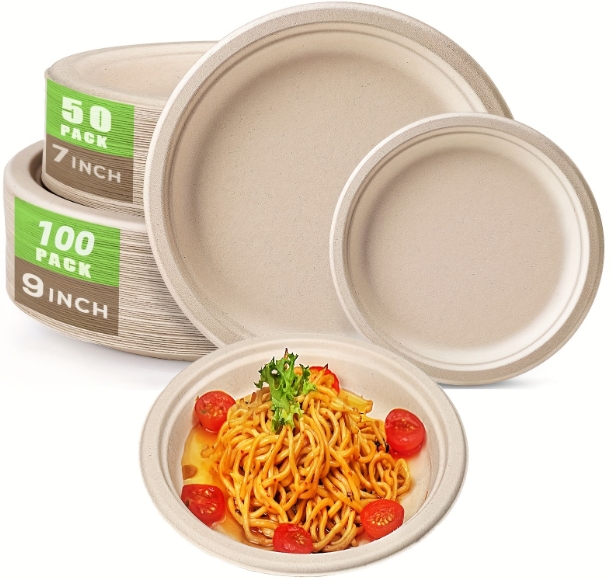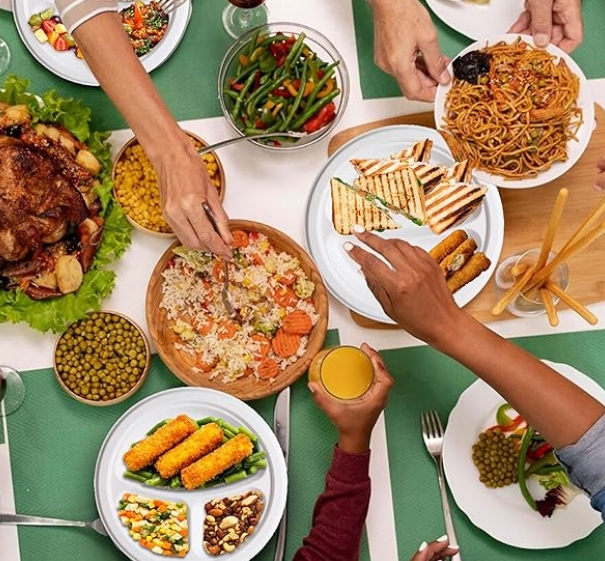
Content Menu
● Introduction to Disposable Tableware
>> Materials Used in Disposable Plates
● Safety Concerns with Disposable Plates
>> Chemical Contamination
>> Microbial Contamination
● Environmental Impact
● Choosing High-Quality Disposable Plates
>> Recommended Brands
● Innovations in Disposable Tableware
>> Future Trends
● Consumer Awareness and Education
● Impact on Local Communities
● Conclusion
● FAQs
>> 1. Are All Paper Plates Safe to Use?
>> 2. Can I Microwave Disposable Plates?
>> 3. What Are the Best Eco-Friendly Disposable Plate Options?
>> 4. How Do I Properly Dispose of Disposable Plates?
>> 5. Are Plastic Plates Completely Avoidable?
● Citations:
When it comes to picnics and barbecues, disposable tableware often seen at picnics and barbecues is a common choice due to its convenience and ease of cleanup. However, concerns about safety and environmental impact have grown, leading many to question whether these plates are truly safe for use. In this article, we will delve into the world of high-quality disposable plates, exploring their materials, safety, and environmental implications.

Introduction to Disposable Tableware
Disposable tableware, including plates, cups, and utensils, is widely used for outdoor gatherings like picnics and barbecues. These items are designed for single-use purposes, offering a practical solution for events where convenience is key. The materials used in disposable tableware vary, ranging from plastic and paper to biodegradable options like sugarcane fibers and bamboo.
Materials Used in Disposable Plates
1. Plastic Plates: Plastic plates are durable and lightweight, making them a popular choice for outdoor events. However, they often contain harmful chemicals like BPA and phthalates, which can leach into food, especially when exposed to heat. This poses significant health risks, as these chemicals are known endocrine disruptors.
2. Paper Plates: Paper plates are generally considered safer than plastic but may contain PFAS, which are linked to serious health issues. However, some paper plates are made from sustainable materials and are PFAS-free. The quality of paper plates can vary significantly, with some being more durable and less prone to leakage than others.
3. Biodegradable Plates: These plates are made from materials such as sugarcane fibers, bamboo, or palm leaves. They are compostable and offer a more eco-friendly alternative to traditional plastic or paper plates. Biodegradable plates are gaining popularity due to their sustainability and reduced chemical risk.
Safety Concerns with Disposable Plates
Chemical Contamination
- PFAS in Paper Plates: Many paper plates contain PFAS, which are known as "forever chemicals" due to their persistence in the environment and potential health risks. However, some brands offer PFAS-free options, which are safer for use.
- BPA and Phthalates in Plastic Plates: Plastic plates often contain BPA and phthalates, which can leach into food, especially when heated. These chemicals are endocrine disruptors and have been linked to various health issues, including reproductive problems and cancer.
Microbial Contamination
Disposable plates, like any food-contact surface, can become contaminated with harmful bacteria if not handled or stored properly. Proper handling and storage practices are crucial to mitigate these risks. Ensuring that plates are stored in a clean, dry environment and used promptly can help prevent microbial contamination.
Environmental Impact
The environmental impact of disposable plates varies significantly depending on their material:
- Plastic Plates: Plastic plates contribute to plastic waste and microplastics in the environment. They take hundreds of years to decompose and can harm wildlife. The production process for plastic plates also consumes significant amounts of fossil fuels, contributing to greenhouse gas emissions.
- Biodegradable Plates: Biodegradable plates, made from materials like sugarcane fibers or bamboo, are compostable and reduce landfill waste. They offer a more sustainable option for outdoor events, as they can easily decompose and return nutrients to the soil.
Choosing High-Quality Disposable Plates
When selecting high-quality disposable plates for picnics and barbecues, consider the following factors:
- Material: Opt for biodegradable or compostable materials to minimize environmental impact. These materials not only reduce waste but also lower the risk of chemical contamination.
- Safety: Ensure the plates are free from harmful chemicals like PFAS, BPA, and phthalates. Look for certifications from reputable organizations that verify the safety of the materials used.
- Durability: Choose plates that are sturdy enough to handle hot and heavy foods without leaking or breaking. This ensures that the plates perform well during use and reduce the risk of accidents.
Recommended Brands
Some brands offer non-toxic and eco-friendly disposable plates, such as Repurpose for paper plates and Ahimsa for stainless steel reusable options. These brands prioritize sustainability and safety, making them excellent choices for those seeking environmentally friendly alternatives.

Innovations in Disposable Tableware
Recent innovations have led to the development of more sustainable and safe disposable tableware options. For instance, some companies are using plant-based materials that are both biodegradable and compostable. These innovations not only reduce environmental impact but also provide consumers with safer alternatives for their outdoor gatherings.
Future Trends
As consumers become more environmentally conscious, the demand for sustainable disposable tableware is expected to rise. Future trends may include increased use of bioplastics derived from renewable resources, which offer a more sustainable alternative to traditional plastics. Additionally, advancements in composting technologies could make biodegradable plates even more appealing by ensuring they decompose efficiently and safely.
Consumer Awareness and Education
Consumer awareness plays a crucial role in driving demand for safer and more sustainable disposable plates. Educating consumers about the risks associated with certain materials and the benefits of biodegradable options can influence purchasing decisions. By choosing eco-friendly disposable plates, consumers can contribute to reducing plastic waste and promoting healthier environments.
Impact on Local Communities
The choice of disposable plates can also impact local communities. For example, communities that adopt biodegradable plates may see a reduction in litter and waste, improving public spaces and wildlife habitats. Additionally, supporting local businesses that offer sustainable disposable tableware can boost the local economy and foster community engagement in environmental initiatives.
Conclusion
In conclusion, while disposable tableware often seen at picnics and barbecues offers convenience, it's essential to choose high-quality disposable plates that are safe for both health and the environment. Biodegradable options are increasingly popular due to their sustainability and reduced chemical risk. By selecting the right materials and ensuring proper handling, you can enjoy your outdoor gatherings with peace of mind.

FAQs
1. Are All Paper Plates Safe to Use?
Not all paper plates are safe. Many contain PFAS, which are harmful to health. Look for PFAS-free options.
2. Can I Microwave Disposable Plates?
Most disposable plates, especially plastic ones, should not be microwaved due to the risk of chemical leaching. However, some paper plates are microwave-safe.
3. What Are the Best Eco-Friendly Disposable Plate Options?
Biodegradable plates made from sugarcane fibers, bamboo, or palm leaves are excellent eco-friendly options. They are compostable and reduce waste.
4. How Do I Properly Dispose of Disposable Plates?
Dispose of plates promptly after use. Biodegradable plates should be composted if possible, while others should be recycled or disposed of in designated waste bins.
5. Are Plastic Plates Completely Avoidable?
While plastic plates are convenient, they can be avoided by opting for reusable or biodegradable alternatives. This reduces plastic waste and minimizes health risks.
Citations:
[1] https://eastdd.en.made-in-china.com/product/xnZYyMFbAvRr/China-Biodegradable-Rectangle-Compostable-Heavy-Duty-BBQ-Picnic-Party-Disposable-Paper-Plates.html
[2] https://thefiltery.com/best-non-toxic-outdoor-dinnerware/
[3] https://www.freshtableware.in/post/eco-friendly-disposable-plates-and-bowls-make-you-fall-sick
[4] https://www.istockphoto.com/photos/plastic-picnic-plates
[5] https://www.made-in-china.com/video-channel/sdhongbo_jmPYpUKogsrg_9-Inch-White-Microwave-Safe-Paper-Plates-Great-for-Picnics-Barbecues.html
[6] https://www.efavormart.com/collections/disposable-plates
[7] https://www.thekayacollection.com/blogs/news/why-use-disposable-plates-convenience-benefits-tips-for-choosing-the-best-ones
[8] https://www.cnnbcy.com/news/industry-news/what-are-the-precautions-when-using-disposable-tableware.html
[9] https://droppe.com/blog/article/how-to-choose-the-best-material-for-disposable-plates-paper-plastic-or-compostable/
[10] https://www.alibaba.com/showroom/disposable-bbq-plate.html
[11] https://www.dawn.com/news/1052157
[12] https://www.youtube.com/watch?v=jbQ12oi4t-E
[13] https://insights.made-in-china.com/What-Is-the-Best-Disposable-Tableware-for-Outdoor-Gatherings_DfPtIlxJtnHE.html
[14] https://ecovermilion.com/en/what-is-disposable-tableware/
[15] https://ecorascals.com/blogs/blog/are-plastic-plates-safe
[16] https://doh.wa.gov/you-and-your-family/food-safety/barbecue-and-picnic-food-safety
[17] https://www.temu.com/20pcs-6-inches-square-dessert-paper-plate-disposable-platter-plate-picnic-paper-plate-barbecue-square-dish-for-restaurant-and-party-g-601099583104754.html
[18] https://www.act.gov.au/health/topics/food-safety/food-safety-and-bbqs-and-picnics
[19] https://www.noon.com/50pcs-disposable-9-inch-plates-disposable-compostable-paper-tableware-set-ecological-degradable-birthday-dinnerware-for-barbecues-camping-picnics-party/ZC4853CB755740B1EFC56Z/p
[20] https://www.walmart.com/ip/Kingsford-Heavy-Duty-Soak-Proof-Paper-Plates-10-Inches-Durable-Plates-Barbecues-Picnics-Holidays-Microwave-Safe-Disposable-Everyday-Use-American-Flag/12630816359
[21] https://in.pinterest.com/pin/746964288297257513/
[22] https://wenzhouqiangsen.en.made-in-china.com/product/mnKRFYgusfpw/China-Environmental-Household-Disposable-Picnic-Barbecue-Cornstarch-Lunch-Plates.html
[23] https://diyecobox.com/health-risks-of-paper-plates/
[24] https://www.aliexpress.com/i/1005006062171894.html
[25] https://www.temu.com/de-en/20-piece-reusable-plastic-paper-plate-holders-set-with-snap-in--dishwasher-safe-made-of-durable-pet-material-10-inch-round-plate-holder-in-assorted-colors-g-601099560391650.html
[26] https://diyecobox.com/health-risks-of-paper-plates-what-to-know/
[27] https://www.made-in-china.com/video-channel/sdhongbo_jmPYpUKogsrg_9-Inch-White-Microwave-Safe-Paper-Plates-Great-for-Picnics-Barbecues.html
[28] https://www.anchenggy.com/blog/disposable-cutlery-food-safety-impact.html
[29] https://www.shutterstock.com/search/picnic-paper-plates
[30] https://www.shutterstock.com/search/paper-plates-picnic
[31] https://www.alamy.com/set-for-picnic-with-tableware-barbecue-grill-and-tasty-food-on-white-background-top-view-image553880915.html
[32] https://www.tiktok.com/@ditsoreviews/video/7487709754651970838
[33] https://www.alibaba.com/showroom/luxury-paper-plates.html
[34] https://www.youtube.com/watch?v=c3rtOJSqzsg

















